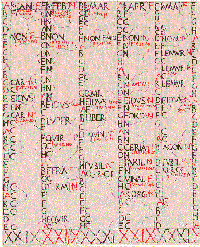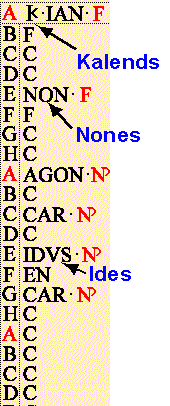The Roman Calendar
Introduction to the Roman calendar
 The calendar used by the Romans went through many changes before the final Julian calendar was established by Julius Caesar in 46BC. But even his version of the calendar was copied from one that had been developed in 279BC. Despite so much upheaval, with subsequent emperors altering the calendar for their own ends, much of our calendar information, the names of the days, the number of days in a month, the months in a year,all emanate from Roman times.
The calendar used by the Romans went through many changes before the final Julian calendar was established by Julius Caesar in 46BC. But even his version of the calendar was copied from one that had been developed in 279BC. Despite so much upheaval, with subsequent emperors altering the calendar for their own ends, much of our calendar information, the names of the days, the number of days in a month, the months in a year,all emanate from Roman times.
|
|
The format may be familiar to the one we use today, with 365 days and 12 months to a year with an extra day every four years. But the way in which the Romans read their calendar, and how they counted days of the month, are vastly different to the current method.
As can be imagined, the Romans did not have 'hang on the wall' calendars. Their's were carved from marble or stone, or painted directly onto a wall. As the calendar would only be chaged once a year, wall painted calendars were a practical idea.
Layout of the Roman calendar

Click on the image above to open it in an larger window
The section below is duplicated in the new window
How to read the calendar
 |
Despite the similarity between the modern calendar and the Roman calendar, the latter is harder to understand due to the manner in which the days are designated. Whereas we number our months from from 1 to 28, 29 30 or 31, the Romans gave days letters and counted the days in an upward fashion to the middle of the month, then down towards the end. |
|
|
|
*Note: For more info on the Roman calendar, visit this page our friends at Romae Vitam's page: Ancient Roman Calendar











 The days of each month were identified by certain letters and names that designated the purpose of the day, or it's position in the month.
The days of each month were identified by certain letters and names that designated the purpose of the day, or it's position in the month.








